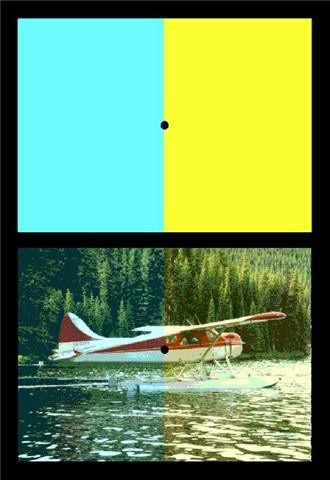Abstract
This project shows that our perceptions can change, even with the stimulus remains the same. A clear color difference in an image disappears after just 20 seconds of looking at another (special) image. Now you see it, now you don't!Summary
Martin, J.H., 1991. Coding and Processing of Sensory Information. in Kandel, E., J.H. Schwarz and T.M. Jessell. Principles of Neural Science: Third Edition. Norwalk, CT: Appleton & Lange.

Objective
This project is about the process of sensory adaptation, specifically, chromatic adaptation in human color vision. The goal of the project is to study and measure:- How quickly chromatic adaptation occurs
- How long the effect lasts
Introduction
The human brain is a wonderful thing. Our sense organs receive a constant barrage of stimuli (the plural of stimulus). Light stimulates photoreceptors. Vibrations of the air move our eardrums and stimulate auditory hair cells. Pressure on the skin stimulates specialized receptors there. Molecules in the air and in our food and drink stimulate olfactory and taste receptors. Our sense organs change these stimuli into electrochemical signals transmitted by neurons. From signals like these, our brains create our perceptions of sight, sound, touch, smell and taste, and this is how we know the world around us. "Colors, tones, smells, and tastes are mental constructions created by the brain out of sensory experience. They do not exist, as such, outside of the brain," (Martin, 1991, 330). Our perceptions are our internal model of the world, not direct reflections of physical stimuli.
One way to see how perceptions differ from physical reality is to study the process of sensory adaptation. In general, when a stimulus is repeated, the response to the stimulus decreases. This is sensory adaptation. Sensory adaptation is a way of "filtering out" stimuli that are constant. From the first level of processing, our nervous system "pays more attention" to changing stimuli than to constant stimuli. For example, your feet feel your socks as you're putting them on, but for most of the day, you're not even aware of them. Part of this has to do with attention, but the skin of your feet also adapts. Another example is background noise. Constant, low noises like a computer fan or the heating system in a room are easily forgotten (that's why we call them "background," after all). If you think about it, adapting to constant stimuli is a sensible strategy: as you're walking outside you probably want your brain paying more attention to the sound of a snowball whizzing past your ear than to the fact that you're wearing warm wool socks.
You can perform a quick experiment right now to see chromatic adaptation in action. The figure below has two sections. On top, a blue and yellow rectangle (with a dot in the middle, called the fixation point), and on the bottom, a picture of a pontoon plane on a forested lake (with a second fixation point). For the experiment, it is best if you can scroll your browser so that both parts of the figure are on the screen at once.
Look first at the image of the airplane, and fix your gaze right on the dot. You'll notice immediately that the lighter portions on the left half of the plane have a definite bluish cast, while those on the right half of the plane have a definite yellowish cast. So far, so good. Now you are going to use the top half of the figure to adapt your visual system. Fix your gaze on the dot between the blue and yellow rectangles for 20 seconds. It's OK to blink normally, but keep your gaze fixed on the dot while your eyes are open. After 20 seconds, shift your gaze to the dot in the airplane image. If you keep your eyes trained on the dot while examining the picture, you will notice that now the lighter portions of the plane now look the same in both halves of the picture. As you continue to look at the plane, you may notice the color differences reappearing.
The goal of this project is to measure how quickly chromatic adaptation occurs and how long the effect lasts. This is one of the methods scientists use to help figure out where in the brain a particular process is occurring. By comparing psychophysical measurements of perceptions with physiological measurements of neurons at various stages of visual processing, scientists can start to piece together how, where and when the brain creates perceptions. You won't be figuring out where chromatic adaptation takes place in the brain with this project, but you will be developing a better understanding of how quickly your visual system adapts to a constant stimulus.
To get started, you should do some background research on the visual system and color vision, to learn more about the physiology behind this effect.
Terms and Concepts
To do this project, you should do research that enables you to understand the following terms and concepts:- Stimulus
- Perception
- Sensory adaptation
- Fixation point
- Color vision
- Color stimulus
- Color perception
- Color after-image
- Cone photoreceptors
- Color opponent processing
Questions
- Are after-images another example of chromatic adaptation? Explain why or why not.
- How many types of cone photoreceptors do humans have?
- What is the difference between a stimulus and the perception of the stimulus?
Bibliography
- Here is a good article on color vision, by Marjorie A. Murray, Ph.D, on the Neuroscience for Kids website, University of Washington, Seattle:
http://faculty.washington.edu/chudler/eyecol.html - Wikipedia article on Color vision:
http://en.wikipedia.org/wiki/Color_vision - Wikipedia article on Optical illusions:
http://en.wikipedia.org/wiki/Optical_illusion
Materials and Equipment
- Computer with color printer
- Stop watch accurate to 0.1 s
- An assistant to help you measure times
Experimental Procedure
- Print out the full-size version of the test image. Open the full-size image by clicking the following link, then print the image from your browser:
Full-size test image - Position the printed image for convenient viewing in a well-lit location. We suggest that you mount the image vertically, about an arm's length away from you, with the center of the image at eye level.
- Measure how quickly chromatic adaptation occurs.
- In the short test suggested in the Introduction, you stared at the adapting image (the blue and yellow rectangles) for 20 s. Your goal is to find out the minimum adaptation time for which you still see the effect.
- Start with 20 s of adaptation, and work down from there.
- You will need to do at least five trials for each time point to assure consistent results (more is better).
- Take a minute or so "time-out" in between trials, with your eyes away from the test images.
- Your assistant will time you as you fixate on the adaptation image, and tell you when to look at the test image.
- Write down the results for each trial in your lab notebook.
- Graph your results. One way to do this would be to calculate for each time point the fraction of trials during which you no longer saw a color difference. Plot this fraction vs. adaptation time.
- Measure how long the adaptation effect lasts.
- In this experiment, you will keep your adaptation time constant (20 s should work well), and you will measure how long it takes before you start to see a color difference on the test image.
- Your assistant should reset the stopwatch at the end of the adaptation period, and restart it just as you shift your gaze to the test image. Tell your assistant when you start to see color contrast in the test image, and write down the time.
- Do as many trials as necessary (at least five) for consistent results.
- Calculate the average duration of the effect.
Ask an Expert
Variations
- Try the experiment with other members of your family or your friends to see whether adaptation times vary between people.
- Does the adaptation effect last longer if you adapt for longer periods of time? Try 40 s and 90 s adaptation times and measure how long the adaptation effect lasts. Graph your results.
- Shifting the fixation point. You may have noticed that the fixation points in the two images are aligned with one another, and that the instructions say to maintain your gaze on this spot. What happens if you keep your eyes fixed when they are adapting, but move your actual fixation point in the airplane picture slightly to the right or left? Make a second print of the test image, and use a pencil to make alternate fixation points at measured distances from the existing one. Fixate normally on the adapting image, but use one of your alternative fixation points for the airplane image. Look carefully and describe what you see. Remember to keep your gaze fixed on the new spot. How is what you see related to the position of the spot? What does this tell you about the spatial extent of adaptation?
Careers
If you like this project, you might enjoy exploring these related careers:











